Pig (original) (raw)
The pig was among the first animals to be domesticated.
Among the first animals to be domesticated by humans, the pig is found everywhere in the world except in Antarctica, North Africa, and far-northern Eurasia. These highly social and intelligent creatures are among the most populous large mammals in the world and are very biologically similar to humans.
What’s the scientific name for a pig? The scientific name for a pig, domestically speaking, is Sus domesticus. The domestic pig is a major food source for humans. Approximately 60 million pigs are found on farms in the U.S. alone, and more than 1 billion are slaughtered annually. Some pig species are classified at various levels of endangerment and examples of many of these species can be found in zoos around the world.
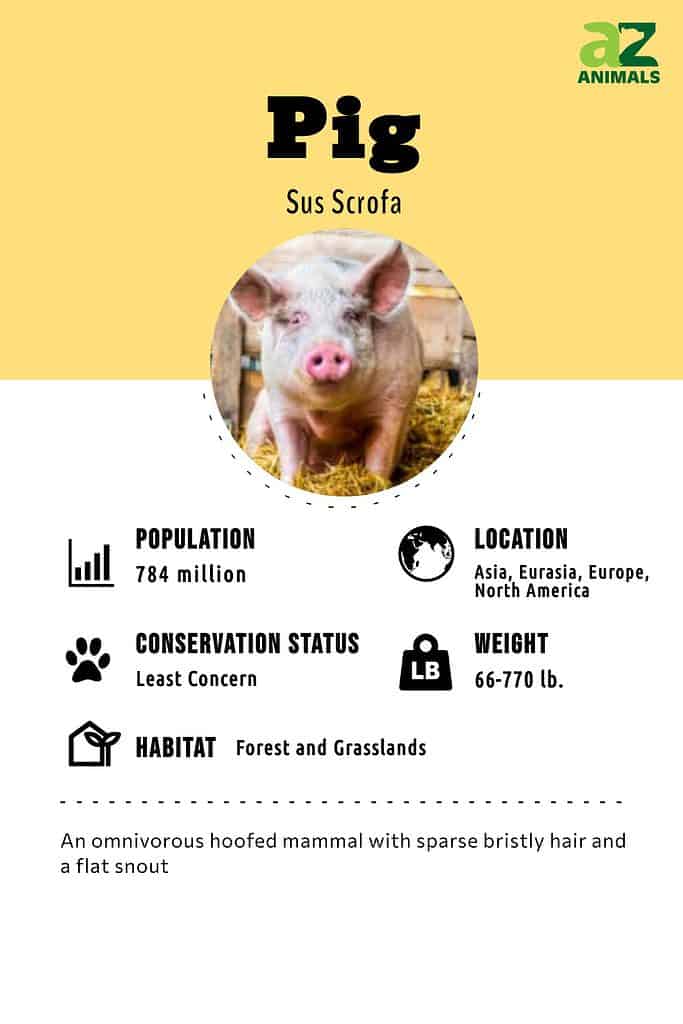
An Incredible Animal: 5 Pig Facts
- Mud Wallowers: Pigs lack sufficient sweat glands to effectively regulate their body temperatures, so they often wallow in mud to cool down on hot days. The mud is also used as a sunscreen and as a way to protect their skin from parasites.
- Highly Intelligent: The pig is among the most intelligent animals on the planet. It can perceive time, remember objects, use learned information to navigate environments, and engage in a range of playful behaviors.
- Unique Among Hooved Animals: Unlike most hooved mammals, pigs do not have multichambered ruminating stomachs, so they can’t subsist off of grass and leaves alone. Also, unlike most hooved creatures, pigs build nests for their young.
- It’s in the Tail: The easiest way to tell if the animal is domesticated or wild is by looking at its tail. Domestic pigs have curly tails while wild pigs have straight tails.
- Hundreds of Breeds: In 2007, the Food and Agricultural Organization of the UN reported that there were more than 740 classifications, or breeds, of the domesticated pig; 137 are listed as extinct, and 130 are classified as endangered.
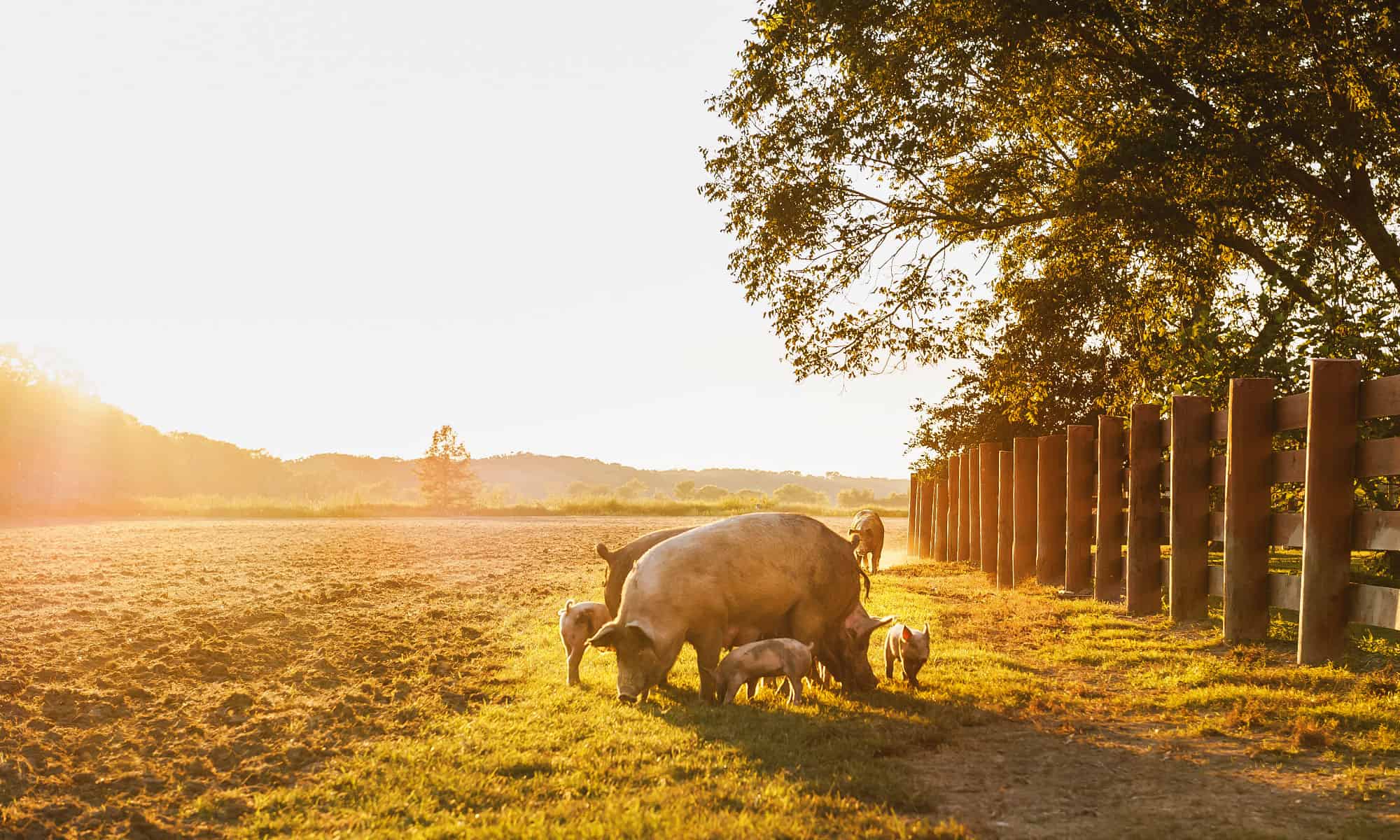
A sow grazing with her litter of piglets.
©ccpixx photography/Shutterstock.com
Scientific Name
The pig is a mammal belonging to the order Artiodactyla and the family Suidae, which is also known as the even-toed ungulate family. That family is further subdivided into another four to eight genera, with domesticated pigs and wild boars belonging to the genus Sus. Species belonging to that genus are regarded as suids or swine; eight living species currently exist.
The scientific word for pig is Sus scrofa, a name which applies to the wild boar, the Eurasian wild pig, as well as the domesticated mammal. But what’s the scientific name for a pig that’s not wild–rather, domesticated?
The scientific name of a pig, or classification, for the domesticated pig, is sometimes extended to Sus scrofa domesticus.
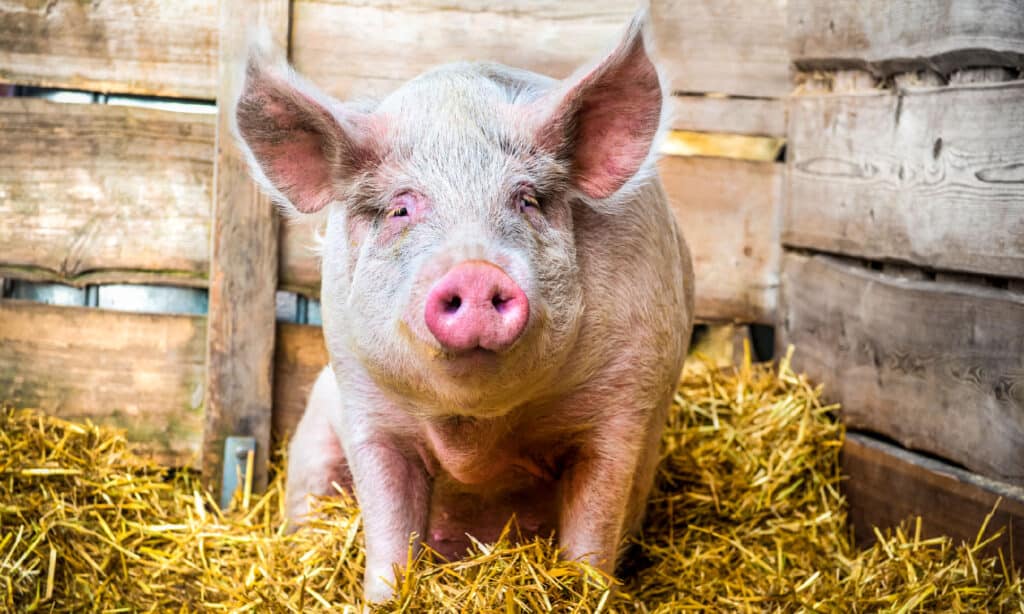
The
scientific word
for pig is
Sus scrofa
, a name which applies to the wild boar, the Eurasian wild pig, as well as the domesticated mammal.
©iStock.com/AlexRaths
Evolution
The domestic pig (Sus scrofa domesticus) originates from the Eurasian wild boar (Sus scrofa). Evidence suggests domestication of this species occurred multiple times and in multiple locations across Asia, Southeast Asia, India, Europe, and Africa. Domestication began approximately 9,000 years ago in Eastern Turkey. In 1539, Hernando de Soto brought domestic pigs to North America, which eventually established the initial populations of “feral hogs.” In the early 1930s, Eurasian boar were released onto hunting preserves in Texas, where some interbred with the feral hogs. Today, there are potentially 3 types of wild pigs in Texas and North America: feral hogs, hybrids between Eurasian boar and feral hogs, and Eurasian boar. There are also hundreds of breeds of domestic pigs of all sizes and colors.
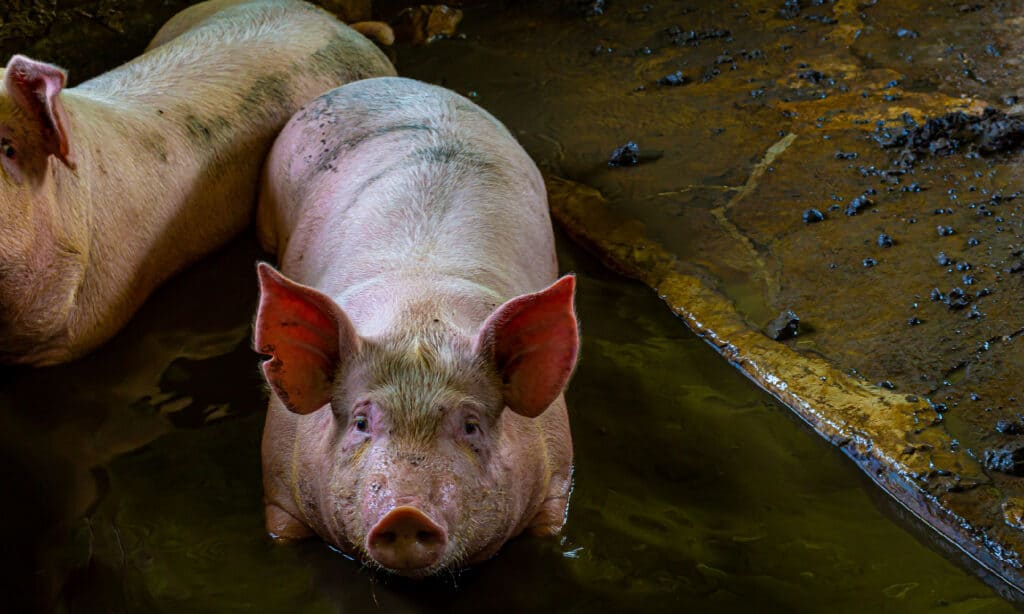
1 Billion pigs are slaughtered every year for food.
©iStock.com/banjongseal324
Appearance and Behavior
Pigs span many genera and species, so they vary a bit in appearance. In general, however, they are known for their stout bodies, short legs, and prominent snouts. On average, they grow to a size of between 300 and 700 pounds. The largest pig of all time, Big Norm of Hubbardsville, New York, weighed 1,600 pounds at his death in 2009. In 2012, a hog named Reggie set the weight record at the Iowa State Fair for Biggest Boar, weighing in at 1,335 pounds.
Most of them have sparse patches of bristles covering their skin. Some have patterns of spots, while others are more uniform in color. They have four hoofed toes on each foot, and their large heads contain a total of 44 teeth. These animals have scent glands covering their faces, and they rub their faces against objects to spread their scent and claim their territory. Their snouts are highly sensitive, and they dig into the soil to root around for food.
Today, there are more than 500 breeds of domesticated pigs in the world. The most popular include the Yorkshire, also known as the large white, which can grow up to 1,000 pounds in size. The Chester White is known for its all-white appearance and medium floppy ears. The Landrace pig, another all-white breed, is particularly prized for its bacon.
Highly social animals, these animals collect in groups called sounders in the wild. These groups consist of two females and their young. Males tend to be more solitary. These animals communicate using a variety of sounds, including squeaks and grunts. They also use various body postures to get their point across. For example, they might raise the crest of hair on their backs, grind their teeth, jerk their head, or cock their ears.
Pigs are biologically very similar to humans. As a result, they are often used in medical experimentation. Their heart valves are sometimes transplanted into human hearts, saving human lives.
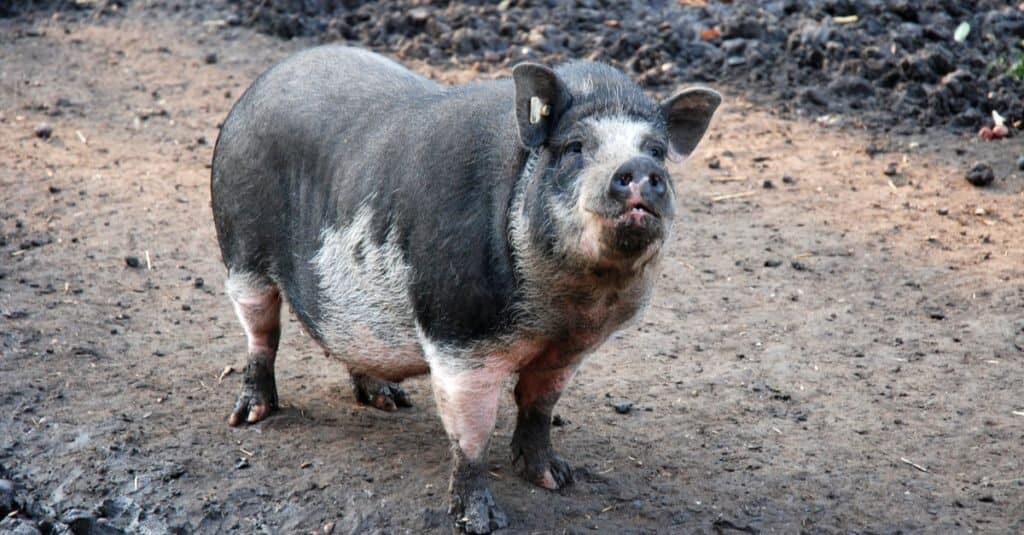
Pigs are highly social animals that live in groups.
©Sinuswelle/Shutterstock.com
Habitat
Domestic pigs are descendants of the wild boar, Sus scrofa, and the Sulawesi warty pig, Sus celebensis. The two swine species diverged from their closest ancestor approximately 500,000 years ago. It is believed that the first pigs originated in China and the Middle East. Wild stocks from which modern domesticated pigs descended are still found in the forests of Africa, Asia, and Europe.
It is believed that the first pigs were introduced to North America during the second voyage of Christopher Columbus in 1492; they first hit the mainland of the continent around the year 1500. They are believed to have been first domesticated roughly 40,000 years ago, making them among the earliest animals domesticated by humans.
These animals have thrived so well because they can survive in a variety of habitats. They are found in grasslands, rainforests, wetlands, scrublands, temperate forests, and savannas everywhere in the world except for Antarctica, Northern Africa, and far northern Eurasia. They are also omnivores and will consume just about anything.
In the wild, their ranges vary in size. The pygmy hog, for example, has a range of approximately 60 acres; the Eurasian wild hog, on the other hand, has a range that can extend to more than 7 square miles in size.
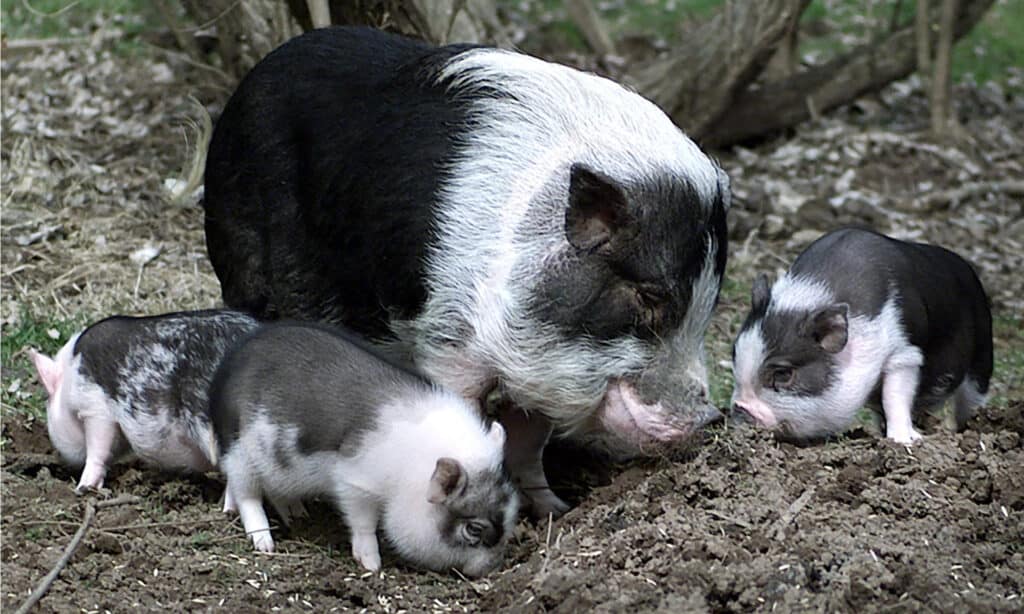
Pigs were first domesticated 40,000 years ago.
©Wendy M. Simmons/Shutterstock.com
Physiology
Although pigs have sweat glands, they don’t rely on perspiration to regulate their body temperature (a habit that places them in the same category as elephants and rhinos). They prefer a cooling dip in a mud pool which might also serve to keep parasites at bay while also serving as a sunscreen too.
Due to an evolutionary mutation, pigs are believed to enjoy a degree of resistance to snake venom. They are one of only four mammals that scientists have found to have such immunity formed from mutation. This puts the pig in the special category with the hedgehog, mongoose, and honey badger when it comes to resisting snake venom. These mutations appear to be independent of each other.
Unlike ruminants which have multichambered stomachs, pigs are monogastric. In other words, they have only a single-chambered stomach. As a result, they are omnivorous and will eat whatever takes their fancy.
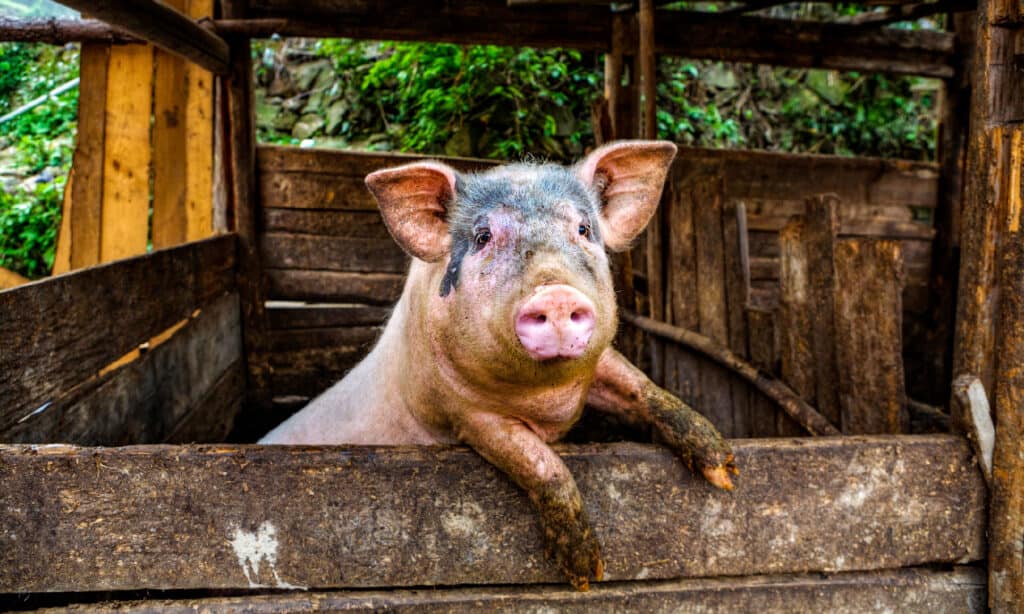
PIgs have a digestive system very similar to humans.
©iStock.com/Grigorev_Vladimir
Diet
True omnivores, these animals subsist off of both plants and animals. In the wild, wild boars primarily subsist off of roots, fruit, rodents, and small reptiles. On the other hand, domesticated swine are fed diets that typically consist of grains like soy, wheat, corn, and barley. They are often given “slop,” which is made up of things like fruit rinds, vegetable peels, and other food scraps. As a result, they are handy to have around because they will eat humans’ leftovers and are not picky at all.
These animals use their snouts to root around in the soil for food. They are famous for being able to find truffles. Their rooting behavior helps the environment by clearing away dead animals, controlling insects, spreading seeds, and breaking up soil, which promotes new plant growth. At the same time, this behavior can be highly destructive to local environments.
Want even more details on what pigs eat? Give our complete guide ‘What Do Pigs Eat’ a read!
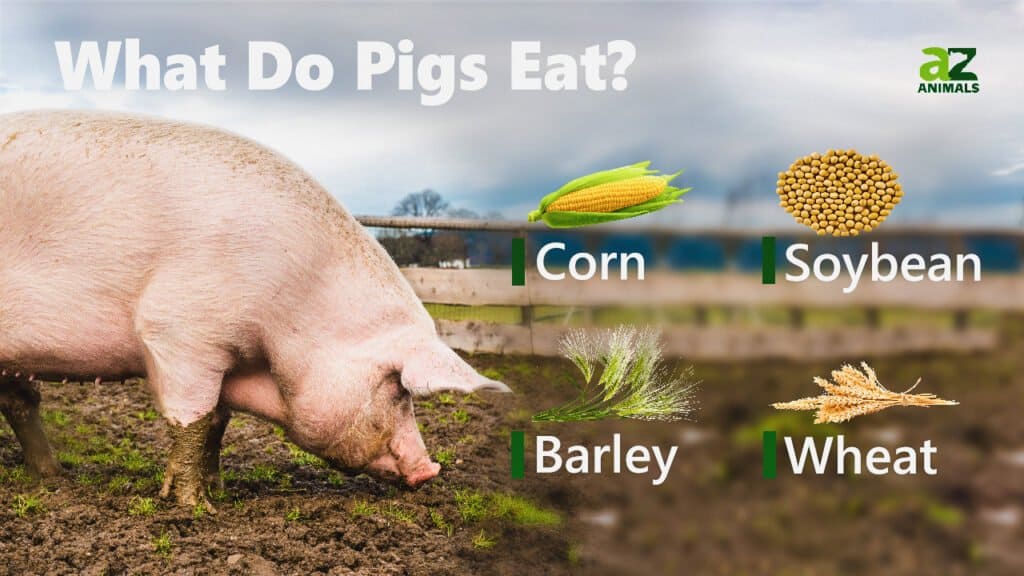
Pigs are omnivores and require a varied diet full of fiber, minerals, and vitamins.
Predators and Threats
Wild pigs are highly adaptable and can survive in a variety of ecosystems, but they do have their predators. Juveniles may fall prey to small mammals such as coyotes, bobcats, foxes, and others. However, humans and mountain lions are the primary predators of wild pigs in North America. In some areas, hunting is used to control populations, while other regions rely on fences or trapping programs to reduce numbers. These methods are helpful for reducing damage caused by wild pig populations, but it’s important to remember that these animals play an important role in the natural ecosystem as well.
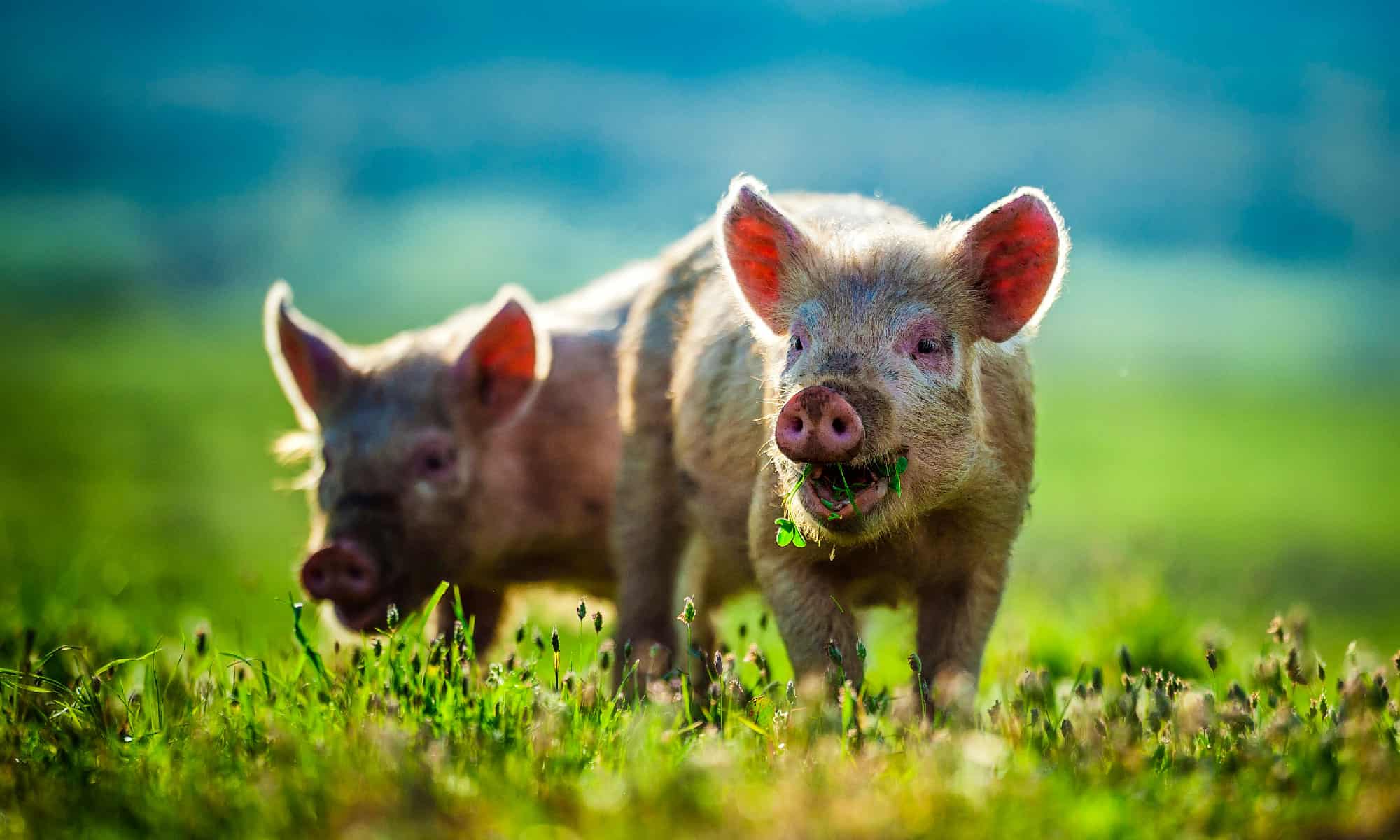
Pigs are omnivores–their diet consists of both plants and animals.
©Chumash Maxim/Shutterstock.com
Reproduction, Babies, and Lifespan
Non-pregnant female pigs, called sows, go into heat every 21 days throughout the year; each heat lasts for eight to 36 hours. Males follow females and nudge them repeatedly to show interest. The female then allows the male to taste and smell her urine. Males usually stay with females for several days before moving on to new ones. The gestation period lasts for three months, three weeks, and three days. Sows make nests for their young within 24 hours of birth. A baby pig is called a piglet, and anywhere from 10 to 13 piglets are born per litter, on average. A female may have a litter of baby pigs up to two times per year.
Newborn baby pigs, or piglets, start feeding within one hour of birth. They are typically weaned after about two to three weeks. At birth, piglets weigh around 2.5 pounds, and they usually double in size within about a week.
Wild pigs and wild boars live for an average of 25 years in the wild. Domesticated pigs have an average lifespan of 6 to 10 years.
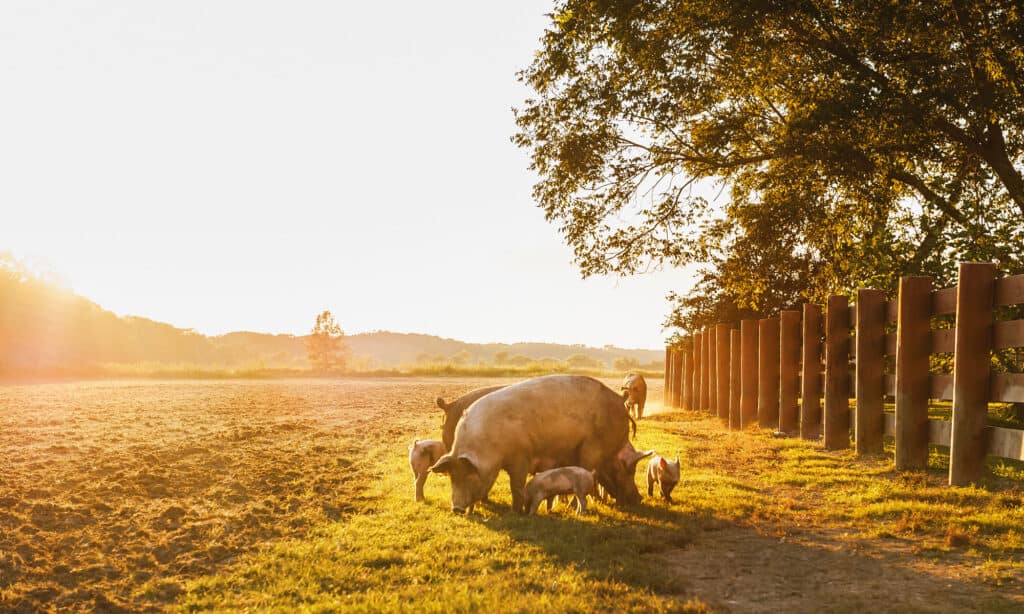
Pigs are pregnant for over three months and have a litter of between 10-13 piglets.
©ccpixx photography/Shutterstock.com
Population
Large populations of feral pigs are still found across the world, including in areas of North America, South America, Australia, New Zealand, and Hawaii. Exact estimates for the total population of wild pigs are unclear. However, it is believed that there are approximately 2 billion domesticated pigs on the planet at any given time. Roughly 1 billion pigs are slaughtered every year, but intensive farming practices make it easy for farmers to keep up with demand.
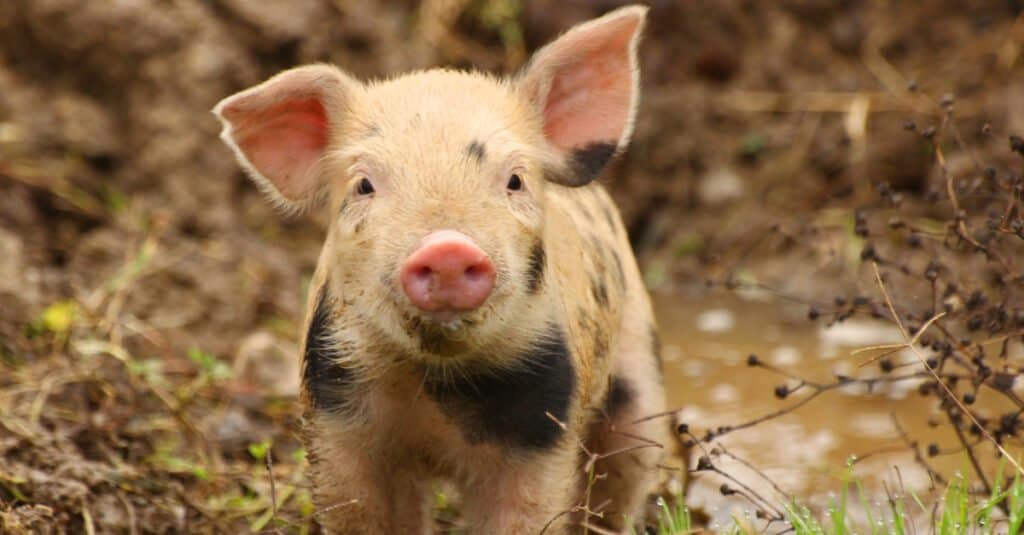
1 Billion pigs are slaughtered for food each year.
©Simun Ascic/Shutterstock.com
Conservation
Most pig species have very stable populations and are not considered to be endangered in any way. However, several species are listed as being endangered by the IUCN. Wild boars are classified as Least Concern, meaning that they are not considered to be endangered. One species, the Sulawesi warty pig, is classified as Near Threatened. Two species, the Palawan bearded pig and the Philippines warty pig, are classified as Vulnerable. One species, the Javan warty pig, is classified as Endangered, and another, the Visayan warty pig, is classified as Critically Endangered.
The biggest threat faced by pigs is exploitation by humans. Pork and pork products, which come from pigs, account for more than 40% of all meat and poultry consumed worldwide as of 2017. Every year, China alone processes more than 500 million pigs for food. The U.S. processes around 64 million per year, Brazil processes around 40 million per year, and Germany process around 27 million per year.
In the Zoo
Pigs of all species are found in zoos around the world. Domesticated pigs are often found within petting zoos of larger zoos, where they are used to let people enjoy up-close-and-personal experiences. Various species of wild pigs are also found in zoos around the globe. For example, the San Diego Zoo has a population of Visayan warty pigs, the most endangered species of the pig on the planet. It was the first zoo outside of the Philippines to breed them, and more than 60 have been born there since 2002. Like many prominent zoos, the San Diego Zoo also boasts red river hogs and pig deer, or babirusa pigs, which are natives of Indonesia.
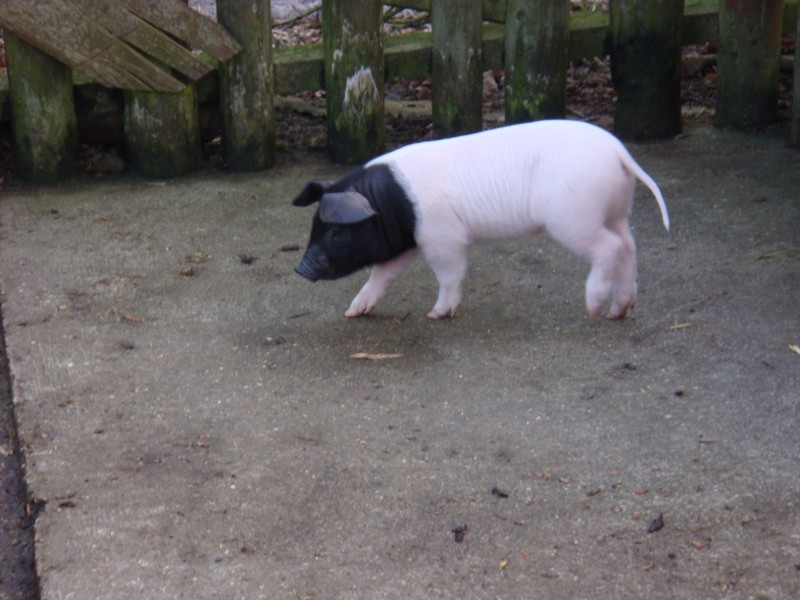
Many zoos have pigs on display.
©Millie Bond – Copyright A-Z Animals
Types of Pigs
- Giant forest hog, Hylochoerus meinertzhageni – Found in Africa, the giant forest hog can grow to a size of up to 6.9 feet long and up to 3.6 feet tall, making it the largest boar species.
- Pygmy hog, Sus salvanius – The smallest species, the pygmy hog grows to an average size of 1.8 feet to 2.4 feet in length, 9.8 inches in height, and 14.5 to 21 pounds in weight.
- Red river hog, Potamochoerus porcus – Also known by the classification of the bush pig, the red river hog is native to Africa and has reddish body hair. It spends a lot of time wading in the water, which is why it is called a river hog.
- Babirusa, Babyrousa babyrussa – Also known as the pig deer, this species is native to Indonesia.
- Visayan warty hog, Sus cebifrons – A native of the Philippines, the Visayan warty hog is classified as Critically Endangered by the IUCN.
View all 229 animals that start with P
Pigs are omnivores.
Pigs have four digits on each hoof, which are called twos. There are two functional toes and two non-functional toes per foot.
Generally speaking, pigs are not dangerous. Their primary defensive measure is their speed, so their first instinct when confronted is usually to run. When cornered, however, pigs may use their tusks to inflict damage on opponents. Their tusks are often razor-sharp, and pigs may repeatedly jab at targets when feeling threatened.
Because they are opportunistic omnivores and will eat practically anything, pigs will, indeed, eat human flesh. However, they are only likely to do so if they stumble upon a dead human body; they are not known to physically attack, kill, and then eat humans.
Unlike most hooved mammals, pigs build nests for their young and do not have multichambered ruminating stomachs. As a result, they are not able to survive off of leaves and grass alone.
No, pigs do not willingly eat their own feces.
Pigs belong to the Kingdom Animalia.
Pigs belong to the class Mammalia.
Pigs belong to the phylum Chordata.
Pigs belong to the family Suidae.
Pigs belong to the order Artiodactyla.
Pigs are covered in Hair.
Pigs belong to the genus Sus.
Pigs live in forests and grasslands.
Pigs eat roots, seeds, and leaves.
The average number of babies a Pig has is 7.
The scientific name for the Pig is Sus scrofa scrofa.
Pigs can live for 8 to 15 years.
A Pig can travel at speeds of up to 11 miles per hour.
Mini pigs do not make good pets for people unprepared for their needs, size at maturity, and potential health issues. However, having mini pigs in the family can be fun and rewarding as long as their human caregivers understand the pitfalls.